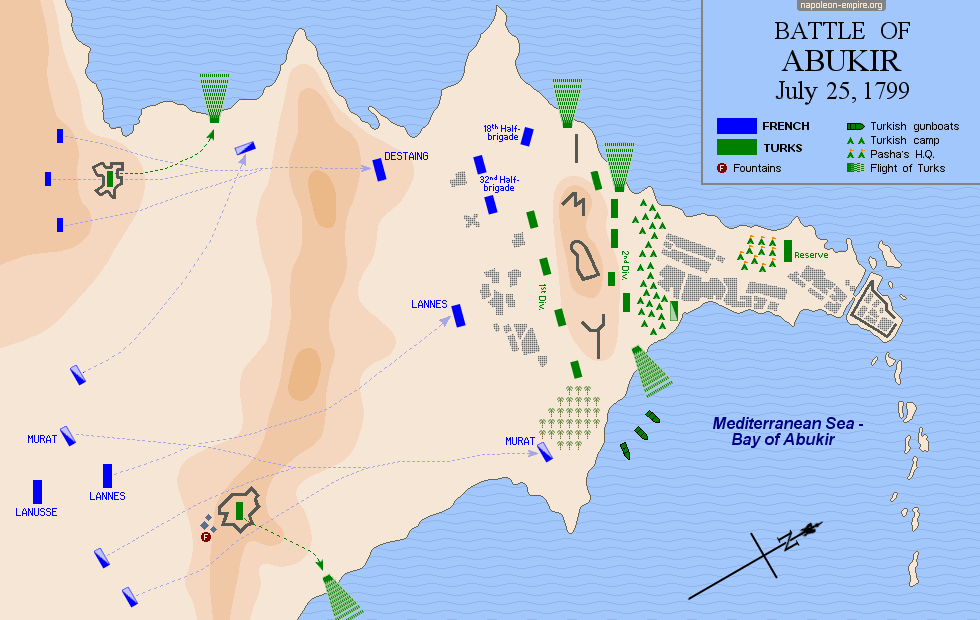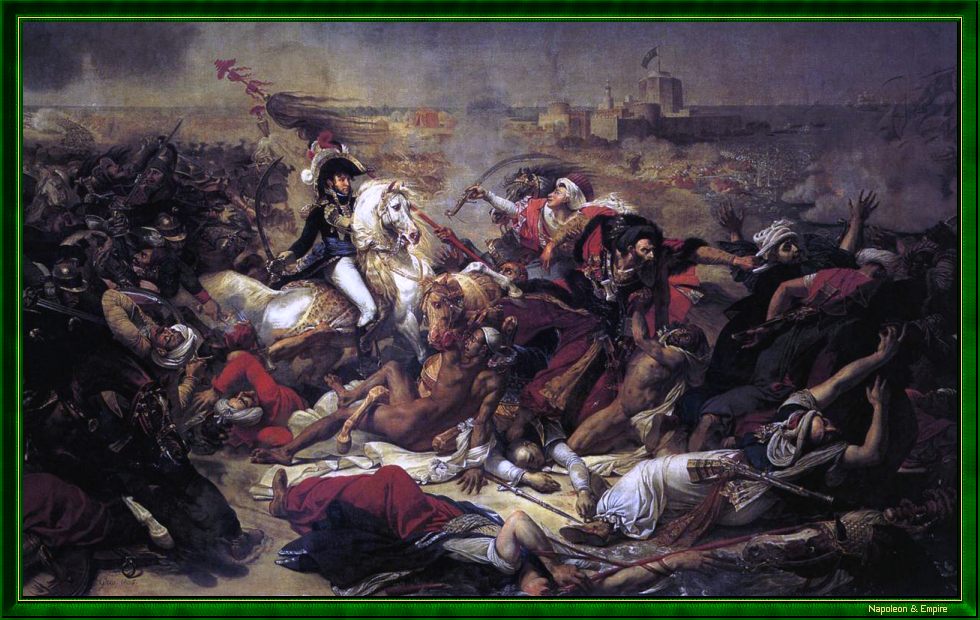Date and place
- July 25th, 1799 on the Abukir (or Abu Qir) peninsula, on the Mediterranean coast of Egypt, twenty-three kilometers northwest of Alexandria.
Involved forces
- French army (11,000 men) under command of General Napoleon Bonaparte.
- Turkish army (18,000 men) under Seid Mustafa Pasha.
Casualties and losses
- French army: 100 to 150 killed, 500 to 700 injured.
- Turkish army: 2,000 killed or wounded, ten thousand drowned, 3,000 prisoners.
General situation before the battle
Since his return from the Expedition in Syria [now the State of Israel], which ended on June 1, 1799, Napoleon Bonaparte had been preparing for the arrival of the Ottoman troops, trying to consolidate his finances, his authority over the population and his army.
Of the 36,000 men who had disembarked with him a year earlier, only 18,000 were fit to fight, and they were poorly equipped and short of ammunition. Unable to hope for reinforcements from France, he recruited native troops: Mamelukes ready to change sides, Greeks, Druze, Copts, and even a few thousand black slaves whom Louis Charles Antoine Desaix was asked to buy. These soldiers, whose education was inadequate and motivation questionable, served only to maintain order.
Bonaparte had not forgotten the Cairo revolt of October 21, 1798. While he was able to leave behind a garrison of 10,000 men during the Syrian expedition, he would not do so this time. To secure his rear when he had to go out to meet the enemy, he decided to resort to the method used by the Mamluks before him: inspire fear.
Suspected pro-Ottoman sympathizers were arrested and executed, the first ones shot, the other ones beheaded to save ammunition; prostitutes who crowded the camps were drowned in the Nile. This policy achieved its goal: with Bonaparte gone, no one would budge.
On the financial front, on the other hand, despite fines and forced loans, money did not flow into the coffers as quickly as had been hoped. This relative poverty was detrimental to French interests.
Preliminaries
On July 14, 1799, news of the arrival of an Anglo-Turkish fleet from Rhodes [Ρόδος] in the roadstead of Abukir [ﺄﺑﻭ ﻖﻳﺭ] [31.32415, 30.07265] reached Bonaparte near Cairo [ﺎﻠﻗﺎﻫﺭﺓ]. He soon learned that thirteen ships of the line, nine frigates, seventeen gunboats and seventy-four transport vessels, all under the command of Commodore Sidney Smith , had presented themselves on the 12th in front of the port and village, which had quickly fallen into the hands of twenty thousand Turks who had disembarked under the protection of English artillery.
The victors moved to the Abukir peninsula to await the cavalry to be brought in by Mourad Bey (ﻡﺭﺍﺩ ﺐﻛ) , the main Mamluk leader.
Napoleon Bonaparte, for his part, immediately sprang into action, giving the enemy no time to consolidate. He assembled all the troops at his disposal: the divisions of Jean Lannes and Antoine-Guillaume Rampon, the cavalry of Joachim Murat, and some of Desaix's cavalry, including Louis-Nicolas Davout. This small army (less than 7,000 men) quickly took the road to Ramanieh [Rahmaniyyah - ﺎﻟﺮﺤﻣﺎﻨﻳﺓ], arriving there on July 19.
By July 22, Bonaparte was in Birket [Birkat Ghattas - ﺏﺮﻜﻫ ﻎﻃﺎﺳ], from where he could easily move on to Alexandria [ﺍﻺﺴﻜﻧﺩﺮﻳﺓ], Abukir 22 kilometers to the northeast, or Rosette [Rashid - ﺮﺸﻳﺩ], 50 kilometers further east, as circumstances dictated. Moreover, this position hindered communications between the landed Turks and the rest of the country, and cut them off from the reinforcements they are awaiting by land.
At the same time, orders were sent to Jean-Baptiste Kléber and Jean-Louis Ebénézer Reynier , then in the Nile [ﻦﻫﺭ ﺎﻠﻨﻴﻟ] delta, to move closer to Abukir. Desaix, for his part, was instructed to evacuate Upper Egypt, leaving garrisons in the forts and Louis Friant in pursuit of Mourad Bey, and to monitor the situation in Cairo during the expedition against the Turkish landing.
After consulting the plans of the fort and the harbor, and learning about the position occupied by the warships, Bonaparte initially decided to immobilize the enemy until Kléber's arrival. But his observations in situ soon led him to change his plan. Firstly, it was quickly established that the English had not landed any troops in large numbers, but had merely sent a few advisors to the Turks. Secondly, the position in which the Turks had established themselves seemed vulnerable.
The Turkish position
A first line, too stretched out, extended two kilometers in front of the village of Abukir, from the sea to Lake Madieh [since dried up]. Each end of the line rested on a dune (Cheik mountain to the west, Puits mountain to the east) defended by around a thousand men; another two thousand occupied the center.
To the rear was a fortified hamlet, then a second line, concentrating the bulk of the Ottoman forces, held the redoubt built by the French across the peninsula. Its defences, left incomplete by the French despite orders to the contrary, have been extended by the Turks to the sea on either side.
Next came the village of Abukir itself [31.32398, 30.06413], where Mustapha Pasha (Seid Mustafa Pasha - ﺲﻳﺩ ﻢﺼﻄﻓﻯ ﺏﺎﺷﺍ) , the Turkish general-in-chief, has set up his reserves and headquarters. Gunboats were in position to support the infantry with their fire. As for the English vessels, due to their draught, they are anchored in the roadstead six kilometers away and cannot intervene.
The French system
Bonaparte went on the attack, deploying his troops as follows:
- Joachim Murat and Jacques Zacharie Destaing in the vanguard with 2,300 men;
- Jean Lannes on the right with 2,700 men;
- François Lanusse on the left with 2,400 men;
- Louis-Nicolas Davout, at the head of 300 cavalry and 100 dromedaries, guarded the lines of communication with Alexandria to the southwest, and was responsible for preventing Mourad Bey's intervention should he appear;
- These different corps shared some fifteen cannons;
- The reserve was formed by the Kléber division, due to arrive later in the day.
The fighting
Destaing on the left and Lannes on the right were each charged with attacking the dune facing them at the far end of the enemy front line. Murat, with his cavalry, was to cross it and fall on his rear. This plan was followed to the letter, and the surrounded Turks had no choice but to throw themselves into the sea, harassed by French hussars and dragoons. Lannes and Destaing fell back to the center, on the fortified hamlet that jutted out in front of the second line of defense. The Turks held out valiantly while awaiting reinforcements, but the column sent to their aid was surprised by Murat, who drove it back.
Bonaparte succeeded in trapping the Turkish army in Abukir. The speed of his victory prompted him to exploit his advantage immediately, without waiting for reinforcements as initially planned. He rested the troops of Lannes and Destaing and marched on the enemy second line with those of General Lanusse, who had remained in reserve until then. He saw a weak point to the left of the Ottoman position, where the coast forms a promontory to the east of Abukir. He placed an artillery battery there, which crushed the Turks under a shower of cannonballs.
As they staggered off to seek shelter, the Turks opened up a four-hundred-meter breach in their defenses. Murat and his cavalrymen rushed in. Hussars and dragoons, followed by Lannes' infantry, rushed the entrenchments. Their defenders, after a valiant resistance, were on the verge of giving in when the French, caught in their turn under heavy artillery fire, were forced to withdraw before they could exploit their advantage.
Bonaparte reorganized his troops and waited for the opportunity to launch another attack. He quickly got it. True to tradition, the Ottomans soon emerged from the redoubt to cut off the heads of the dead for trophies. Two French battalions were sent to interrupt this sinister task. Murat and his cavalry followed them.
Galvanized by the indignation they felt at the thought of the bodies of their fallen comrades being treated as trophies, the French marched on the redoubt, took it and, in their rush, reached the camp of the enemy pasha, Mustapha.
Mustapha wounded Murat in the face, who retaliated by cutting off a few of his fingers (two or three, according to sources) with his saber, taking him prisoner and threatening him: If you ever do that to my soldiers again, I swear by Allah I'll cut off more important things
.
Deprived of their leader, the "osmanlis" panic. They rushed to the sea to try and get back on board their boats. Most of those who were not sabred drowned. The English commodore Sidney Smith, who had disembarked as an "advisor", was himself almost caught.
Results
The landed army was destroyed. It lost 100 flags, 32 artillery pieces, 400 horses and all its baggage. Barely four thousand Turks escaped the disaster and locked themselves in the fort. Victory was total.
Bonaparte left immediately for Cairo, leaving Jacques-François de Menou to finish the job, which would take a few more days for hunger and thirst to take their toll. The survivors surrendered on August 2.
Bonaparte was not far from the truth when he wrote that not a single man of the landed army escaped. The French, for their part, deplored a hundred killed and 500 wounded.
Paradoxically, this victory was the reason for Bonaparte's departure. During the negotiations that followed, the English cleverly sent him a selection of newspapers that revealed the catastrophic military situation in which France found itself in the spring. After a night of feverish reading, the General-in-Chief made his decision: he would return to France.
Map of the battle of Abukir (or Aboukir)

Picture - "Battle of Abukir, July 25th, 1799". Painted 1806 by Antoine-Jean Gros.

Jean-Baptiste Kléber, who arrived too late for the battle, couldn't believe his eyes when he visited the battlefield, and returned to Bonaparte, about whom he had often been critical: General, allow me to embrace you, you are as big as the world
.
Joachim Murat was promoted to major general on the evening of the victory.
Photos Credits
Photos by Lionel A. Bouchon.Photos by Marie-Albe Grau.
Photos by Floriane Grau.
Photos by Michèle Grau-Ghelardi.
Photos by Didier Grau.
Photos made by people outside the Napoleon & Empire association.